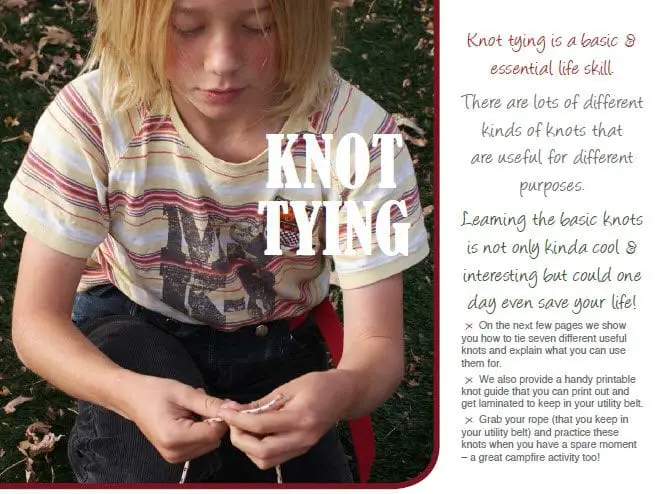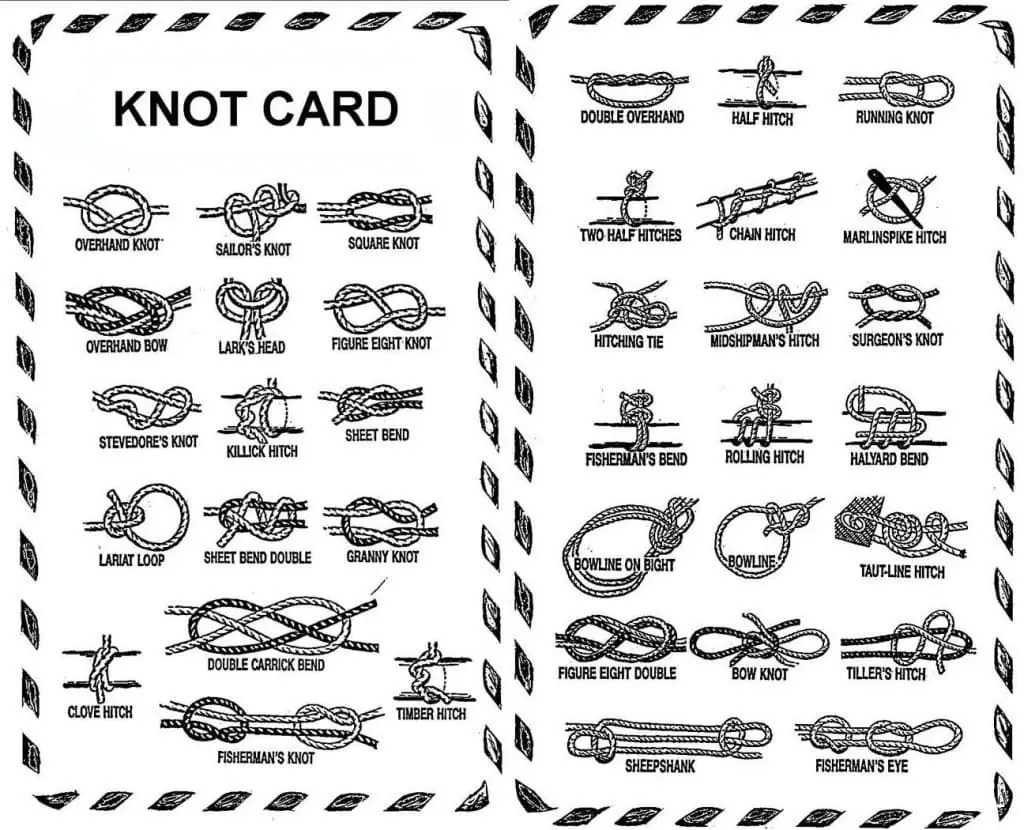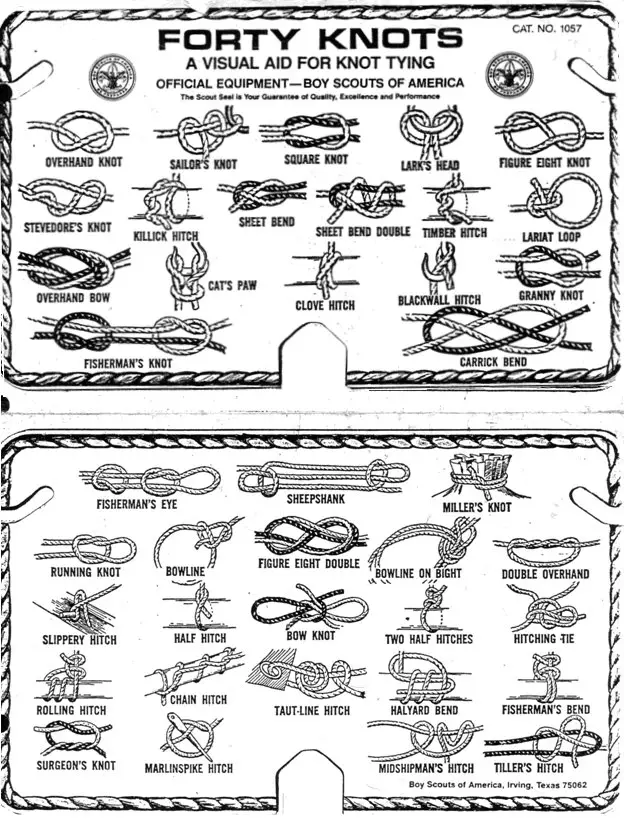Download and print out these handy knot guides and wallet cards for easy reference.
You’ll always have the means to tie the knots you need right at your hip.

Why Learn Knots?
With the right knots you can secure gear to your pack, secure a tent’s guy lines to a tree, strap a canoe to the roof of your wife’s minivan (while she’s freaking out about it), pull a friend out of a chasm, and allow you to repel down that same chasm to get the crap he dropped when you pulled him up.
There are plenty more practical applications knowing knot tying, but equally notable is learning them is fun and good for you! Knot learning keeps your memory strong, and your hand-eye coordination on point.
Here are some handy knot guides that you can print out, so you can have one with you all at times.
Printable Handy Knot Guides List
#1 – Forty Knots: A Visual Aid for Knot Tying. This is the official Boy Scouts of America Official Equipment card.
#2 – Wallet Card 1: Here’s a simple knot card that you can print out, fold then laminate for wallet carry.
I’ve just used packing tape, carefully laid, to laminate the front and back of cards. Then just cut and trip the excess close to the edges. Easy and cheap.
#3 – Forty Knots Card: Here’s a similar card – knot card.pdf – with a horizontal layout you can download and print later. It features a few more knots, but has a bit less clarity.
| List of knots featured:
Overhand, square, sheet bend, sheet double, granny, sheepshank, double overhand, bowline, running, figure eight, overhand bow, double carrick bend, bow, figure eight double, clove hitch, half hitch, timber hitch, hillick hitch, halyard bend rolling hitch, fishermens bend, two half hitches, chain hitch, taut line hitch, slippery hitch, midshipmanss hitch, tillers hitch, bowline on bight, lariat loop, cat’s paw, larks head, blackwall hitch, fisherman’s knot, fisherman’s eye, hitching tie, surgeon’s knot, marlin spike hitch miller’s, sailor’s, stevedore’s. |
To use these cards effectively, we recommend first practicing the knot sequences to burn it into your muscle memory.
One drawback of knot cards is they do not show the steps, just the expanded knot layout, or arrangement.
Knot cards are best for helping you remember which knots you’ve practiced and how to utilize them in the real world.
#4 – 7 Essential Knots Guide: If you are looking for a free guide on how to tie a few essential knots, we highly recommend this guide.
 |
| List of knots featured:
Knots Bowline, sheet bend, figure eight, reef, clove hitch, double half hitch, blood. |
This guide provides great place to start learning, and features clear step-by-step illustrations on how to perform each knot sequence and includes printable cards that shows each step in the knot tie sequence.
See page 5 for the printable knots. I could not find who produced this guide, so if any of you know please leave a comment so I can site the source.
If you know of any other handy knot guides I should feature in the post, please leave a comment with a link to the guide!
If you want to dive deeper into the knot tying world, you may want to pick up a book or two discussing knots, and how to tie and dress them properly.




That’s what I need to learn. How to tie various knots.
Here is another good place to look for knots
https://www.animatedknots.com/index.php?LogoImage=LogoGrog.jpg&Website=www.animatedknots.com
Has anyone ever actually used a sheepshank? I know how to tie it just never found a use for it!
I’m a sailor and it’s one of the knots you are expected to know, yet I’ve never seen anyone use it. I just don’t trust it.
I believe its ‘official’ purpose is to shorten a rope that is too long… However, unless it is kept under tension, I find it just falls apart…
To be useful, I think of it as making two bights and throwing half hitches over them… to stop it just falling apart, throw a second half hitch over each end of loop…
Under load, a rope will stretch especially nylon or synthetic ropes. This stretching will loosen the rope that may have complex knots at either end of the rope. I have successfully used the sheepshank to retighten tractor-trailer rolling stock loads without untying either end. It works well under load and is trustworthy. Never had one slip or break.
This knot was used when making keel grablines on ships lifeboats in the days before totally enclosed and freefall boats. The knot was held in place by small bits of twine that could be broken or cut easily so that if the boat was capsized you could climb on the upturned hull and use the grablines to assist in righting the boat .
I have. I use to fly gliders in Texas. I couldn’t make it back to the air field so I land in a farmers field. Call the operation and the tow plane landed in the field. We realized that the tow rope was too long for the field so we used a sheep shank to shorten the rope. Worked great!
I used one to tow a disabled car out of the street once (5/8″ rope). Isn’t the strongest knot out there, but it didn’t jam when put under a load.
Want to Learn good Knot Tying Go To http://www.outdoorcharts.com … Waterproof
Get “Ashley Book of Knots”.
Brilliant
thanks for sharing!